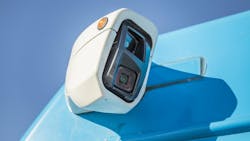STM pilots system combining camera and high-def screens to replace rear-view mirrors
The Société de transport de Montréal (STM) launched a one-year pilot program to evaluate the effectiveness of new rear-view bus safety system that ditches the familiar mirrors and replaces them with a combination of rear-view cameras and high-definition screens.
STM says the pilot of this “cutting-edge system” is one of the first of its kind in North America with the technology expected to benefit all road users.
Two buses have been equipped with the system and will operate in service with STM Executive Director of Bus and Métro Operations Marie-Claude Léonard saying the drivers participating in the test were enthusiastic and offering her gratitude toward union representatives for their involvement.
“This is a promising project that employs our teams’ innovative minds to find solutions to very real problems, while aligning with the city of Montréal’s Vision Zero principles,” said Léonard.
STM says testing, validation and fine-tuning of the system occurred in a closed course prior to the pandemic and road testing represents an important milestone in the evaluation process.
The expected primary benefit of the system will be in reduced vehicle blind spots, an increased field of vision for the driver and improved visibility in difficult conditions such as darkness, bright sunlight, precipitation and tunnels. Additionally, the system is more compact and sturdier than rear-view mirrors and the number of buses that require service due to broken mirrors is expected to be reduced. STM is also evaluating if the transition to rear-view cameras could lead to long-term savings, based on the new system’s expected life span.
To ease the transition from buses with rear-view mirrors to ones with cameras, the screens are located on the pillars to the left and right of the driver’s compartment, which maintains a driver’s visual scanning habits at the wheel.
STM has also designed a device that uses the pneumatic system already installed on all STM buses to keep the camera lenses clean. The device, which can be activated automatically or on demand, directs a jet of forced air into the camera lens to clean it.
As part of the pilot project, the STM will assess the system in terms of performance in various conditions, robustness, reliability and driver satisfaction. The results of these tests will help the STM decide whether to equip the rest of its current and future vehicles with this type of system.

Mischa Wanek-Libman | Group Editorial Director
Mischa Wanek-Libman is director of communications with Transdev North America. She has more than 20 years of experience working in the transportation industry covering construction projects, engineering challenges, transit and rail operations and best practices.
Wanek-Libman has held top editorial positions at freight rail and public transportation business-to-business publications including as editor-in-chief and editorial director of Mass Transit from 2018-2024. She has been recognized for editorial excellence through her individual work, as well as for collaborative content.
She is an active member of the American Public Transportation Association's Marketing and Communications Committee and served 14 years as a Board Observer on the National Railroad Construction and Maintenance Association (NRC) Board of Directors.
She is a graduate of Drake University in Des Moines, Iowa, where she earned a Bachelor of Arts degree in Journalism and Mass Communication.



